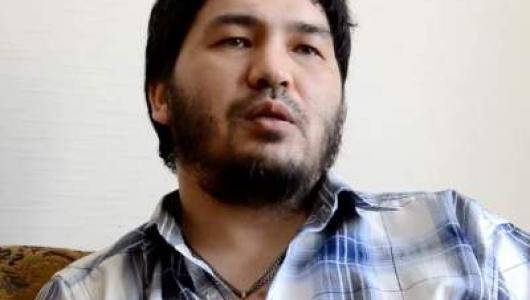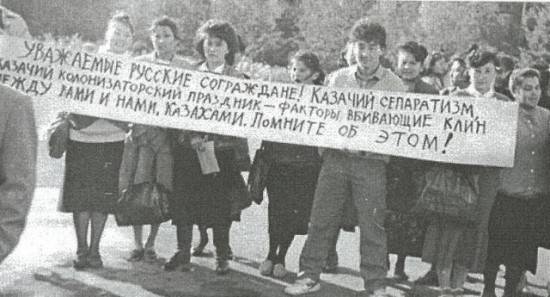Kazakhstan refused to Cyrillic. What's next?

Nazarbayev himself has repeatedly said that all advanced countries of the world use the Latin alphabet, therefore it is advisable for Kazakhstan to switch to the Latin alphabet. Of course, the desire to distance itself from Moscow as the reason for the transition to the new writing is denied in Kazakhstan. Representatives of the Kazakh authorities claim that the country will continue to cooperate with Russia, since there is simply no way out of it - yet story common, and a huge land border, and a large Russian population in Kazakhstan (by the way, Kazakhs live in Russia - in Astrakhan, Orenburg, Volgograd, Omsk and Novosibirsk regions and a number of other regions). But it is difficult not to discern political implications in the transition to the Latin, especially in such an interesting time.
The Cyrillic alphabet played a huge role in the formation and development of the Kazakh alphabet. Despite a certain spread of Arabic writing, the true development of writing in Kazakhstan began with the approval of the Cyrillic alphabet. In the 19th century, missionary alphabets, developed, by the way, by the Kazakhs themselves, appeared. So, one of the first Cyrillic alphabets for the Kazakh language was developed by Ibray Altynsarin - a native of the Kazakh Kypchak tribe, a state councilor (this is about the issue of national discrimination in the Russian Empire) and an inspector of Kazakh schools in the Turgai region. However, the missionary alphabet received a very limited distribution - the elite of the Kazakh tribes, especially in the south, continued to use Arabic writing, and the majority of Kazakhs were generally illiterate and did not know how to write in one language. The Arabic letter could not convey all the phonetic originality of the Turkic languages, therefore there was a need to create a special script based on either the Cyrillic or Latin alphabet.
First, in the middle of 1920-ies, Yanalif was developed - a single Turkic alphabet based on Latin. However, in light of the deterioration of Soviet-Turkish relations and the changing global political situation, in 1938, the transition of the Turkic languages of the USSR to the Cyrillic script began. In the Kazakh Cyrillic alphabet - 42 letters, in the new alphabet on the basis of the Latin letter - 32 letters.
The decision of Nursultan Nazarbayev on the transition to the Latin script was perceived ambiguously by both Russians in Russia and Kazakhstan, and the Kazakhs themselves. The fact is that the adoption of the new alphabet proceeded according to the infamous principle “we wanted the best, but it turned out as always.” Many Kazakhstani philologists were horrified by the number of apostrophes contained in the variant of the Latin alphabet that attracted Nazarbayev. Apostrophes not only make reading difficult, but also create serious obstacles to working on the Internet. However, this particular. Much more interesting is the political rationale for making such a decision, which is undoubtedly present.
The transition of a number of post-Soviet republics to Latin alphabets began in the 1990-x - 2000-s. Now Cyrillic writing has remained in Tajikistan and Kyrgyzstan. In Uzbekistan, Turkmenistan, Azerbaijan, the Latin alphabet has long been used, and now Kazakhstan will be included in this list. Meanwhile, firstly, the Latin alphabet is not historical for the Turkic languages of Eurasia, the translation of writing on its basis cannot be explained by considerations of the restoration of historical justice or the revival of traditions. Where there really were their own traditions of writing, no one even thought of abandoning them even in Soviet times. Latin script remained in Latvia, Lithuania, Estonia, where it really is traditional. Armenia and Georgia have their own writing systems and, by the way, even Georgia, which demonstrates the maximum desire for rapprochement with the West, has never tried to switch to the Latin alphabet - the Georgian people simply will not understand such a decision.
It is difficult to explain the reform of writing in Kazakhstan and the needs of economic or scientific and technological development. For example, such dynamically developing countries of the world as Japan, China, the Republic of Korea, India and do not think to translate their languages into the Latin alphabet. Writing, radically different from Latin, does not hinder them in economic development and scientific and technical progress. However, in Kazakhstan they think otherwise. Not only that great attention in this republic is paid to the study of English as the language of international communication, but also the Kazakh language was decided to be fully translated into Latin. Nazarbayev’s political ambitions can and will be met — will go down in the history of Kazakhstan as a “writing reformer,” but will the population of the country benefit? Most likely, not only Russians and Russian speakers (of whom there are many ethnic Kazakhs) will lose, but also the Kazakhs themselves.
It is clear that the transition to the Latin alphabet is another political gesture. It combines perfectly with the general policy of ousting the Russian language in Kazakhstan. Of course, there may be many defenders of Nazarbayev’s policy, who will argue that there is no problem of national relations in Kazakhstan, you can speak Russian fluently and no one Russian-speaking citizens persecute. In fact, the policy of de-Russification in Kazakhstan and in other former Soviet republics of Central Asia has been going on for a very long time. Another thing is that in Kazakhstan, due to the large number of Russian and Russian-speaking population, it is not as noticeable as in neighboring Uzbekistan or Turkmenistan.
But the nature of political regimes that exist in post-Soviet Central Asia is similar - they are based on nationalism, based on the opposition of the national tradition of Russian tradition and culture. Russian language, Cyrillic writing, Russian literature personify in the eyes of the Central Asian nationalists the political and cultural influence of Russia, which it is unpleasant for them to think about. National identity in the post-Soviet republics is built on the opposition of Russia, and officials can swear Moscow in eternal friendship and the warmest feelings for Russia and Russians, but in practice they heroize participants of anti-Russian uprisings and even collaborators of the Second World War, completely overturn the history of the republics of the times of the composition of the Soviet Union ignore the contribution that Russia and the Russian people made to the economic, cultural and social development of Central Asia. The struggle with the Cyrillic alphabet perfectly fits into the general scheme of the suppression of Russian culture. With this, Kazakhstan, following Uzbekistan and Azerbaijan, relieves itself from the need to preserve the memory that "the Russians invented writing to you."

The famous Kazakhstani public figure and politician Yermek Taychibekov, a recent political prisoner, widely known for his pro-Russian sympathies, believes that Nursultan Nazarbayev, who diligently squeezes the Russian language and Russian culture, is not so much the pro-American lobby the side of the public life of the country.
Nazarbayev’s goal is to build a mono-ethnic state that will be dominated by the principle of “one nation - one language”. All those who do not master the Kazakh language in due measure will remain “on the outskirts” of the public and political life of the country. Already, there is a huge disproportion between the total number of the Russian population in Kazakhstan and the number of Russians standing in high positions in various structures of the republic. Traditionally, there is a higher percentage of Russians and Russian speakers in business, science, and technical fields, while Kazakhs have long dominated power structures, education, culture, and the mass media.
Critics of the current Russian government are trying to explain Nazarbayev’s nationalistic aspirations with a fear of a Russian national revival in northern Kazakhstan along the lines of Donbass. However, they forget that the Kazakh nationalists became more active in the republic a long time ago. Those people who are at the turn of 1980-x - 1990-x. went to the nationalist rallies, already in 50-70 years, new generations of Kazakhs grew up, brought up in a post-Soviet school with the dominance of nationalist ideology. For them, Russia is a colonizing country that brought only evil to the Kazakh land (at least take constant speculations about the genocide of the Kazakhs in the 1930s, although at that time Russian and other Slavic peoples of the Soviet Union suffered even greater human losses).

Of course, Nazarbayev’s supporters may appeal to the fact that in Russia the languages of numerous peoples of the Russian Federation are not state languages at the national level. But Russian in Kazakhstan, firstly, is native to the majority of the population of the northern regions of the country, including ethnic Kazakhs, and, secondly, for more than a century served as the language of interethnic communication, in which both Russian and Kazakh could communicate with each other , and German, and Pole, and Uigur. The importance of knowledge of the Russian language is well understood by the Kazakhs themselves, who want their children to master the Russian language. The concept of the “trinity unity of languages,” introduced by Nazarbayev since 2007, has not yet taken root in practice, which is not surprising - it is difficult to imagine the equality of the English, Kazakh and Russian languages in the field of everyday communication in Kazakhstan. In addition, the Kazakh language is not competitive in learning for those who are good or good at other world languages. It is more sensible for a Russian resident of Kazakhstan to learn English than Kazakh, as well as a Kazakh who grew up in a Russian-speaking family and environment, knowledge of English rather than Kazakh will give much more advantage. This is a fact and there is nothing offensive for native Kazakh speakers.
Not all languages of the world are equally demanded. There is French, and there is Khmer, there is English, and there is Uigur, there is Spanish, and there is Tamil. Possession of the Kazakh language is necessary for the Kazakh in order to preserve their national identity, to respect the traditions of their ancestors and their origin, but for a foreign language person, knowledge of the Kazakh language is not necessary. Here Nigeria - the former British colony with the official language of English. There live hundreds of African nations. It is easy to imagine what kind of slaughter will start if every nation of the country wants its language to be recognized as the only state language of Nigeria. The same is true in the post-Soviet space. In a country where at least a third of the population is ethnically Russian and at least half is Russian-speaking, the total ousting of the Russian language means real discrimination.
The situation of Russians in Kazakhstan, of course, is much better than in other republics of Central Asia or the Baltic states, but it can hardly be called good, especially considering the specifics of the Kazakh mentality. In a society permeated by clan and tribal ties, the modern Russian-speaking population (which includes Russians, Ukrainians, Belarusians, Poles, Kazakhs and Jews of Kazakhstan, and even partly Koreans) is unable to compete with representatives of the “title” nation. Moreover, the government tacitly supports the regime of maximum preferences based on nationality. Populated by Russian and Russian-speaking north of Kazakhstan, Nazarbayev’s entourage is most concerned about his political loyalty. Of course, ideally, Kazakh nationalists would prefer full emigration of the entire Russian and Russian-speaking population to Russia, but since Nazarbayev himself is well aware that this is not possible, the only optimal option is to “clear out” the social and political space of Kazakhstan from Russian influence.
Of course, some of the Russian Kazakhs will prefer to learn the Kazakh language in sufficient volume and will demonstrate maximum loyalty to the existing government. But another part of the Russian-speaking population will prefer to emigrate to Russia, or will be in a marginal position, being forced out into the realms of undervalued labor. The problem of de-Russification of Kazakhstan is much more complex and large-scale and is not limited only to questions of language and writing, and Russia, as a country claiming the role of a great power, political and economic locomotive of Eurasia, should keep all these processes under control and find its levers of influence and pressure on the post-Soviet states.
Information